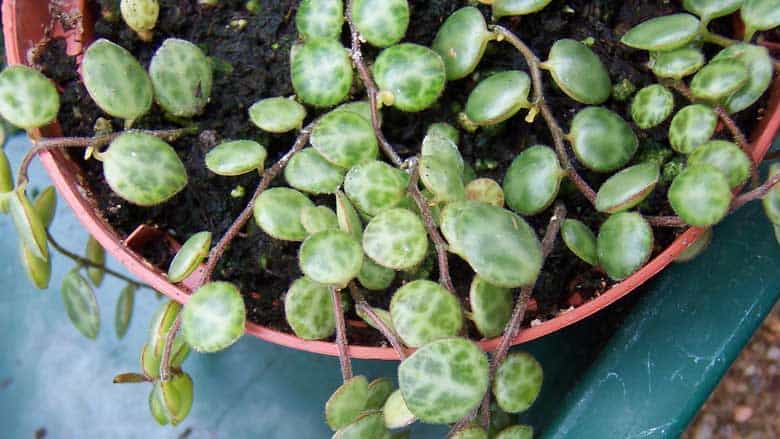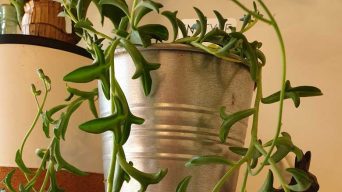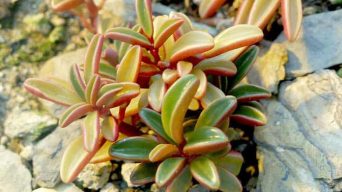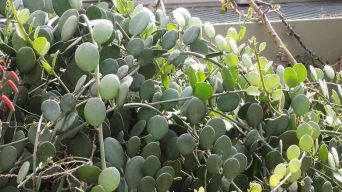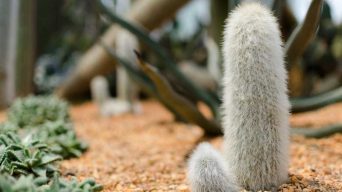Growing a Peperomia prostrata succulent, known as String of Turtles, is a rewarding experience.
It’s a succulent perennial with trailing stems, small oval leaves that are silvery green, and clusters of yellow flowers.
String of Turtles is an excellent choice for hanging baskets and terrariums, and it’s easy to propagate.
They are low-maintenance and do not require much attention to stay healthy. It is, however, essential to provide String of Turtles with the proper care and environment for optimal growth.
This guide outlines everything you need to know about String of Turtles care and propagation.
Overview
| Family: | Piperaceae |
| Genus: | Peperomia |
| Botanical Name: | Peperomia prostrata |
| Common Names: | String of Turtles |
| Origin: | Ecuador |
| USDA Hardiness Zones: | 11a – 11b |
| Size: | 3 – 4 inches wide (7 – 10 cm) and spreads up to 24 in. (60 cm) |
| Light Exposure: | Bright indirect light |
| Water Needs: | Water thoroughly but infrequently |
| Soil Type: | Well-draining soil |
| Fertilizer Needs: | Feed at least every four weeks during the growing season |
| Temperature: | 65 to 80˚F (18 to 27˚C) |
| Humidity Levels: | 60-65% |
The String of Turtles is a succulent perennial with trailing stems, small oval leaves that are silvery green in color, and clusters of yellow flowers. It has woody stems and can reach up to 24 in. (60 cm) when given the proper care and conditions.
Peperomia prostrata should be grown in bright indirect light with well-draining soil, watered thoroughly once a week, and fed every four weeks during its growing season.
It does best when kept at an average temperature of 65 to 80°F (18°C-27°C) with humidity levels at 60% to 65%.
String of Turtles can be propagated by stem and leaf cutting. With the proper care and conditions, String of Turtles is a beautiful addition to any garden or home.
How To Care for String of Turtles (Peperomia Prostrata)
String of Turtles (Peperomia Prostrata) is a unique and beautiful succulent plant that adds character to any home, office, or garden.
Its namesake comes from the individual leaves resembling small turtle shells.
If cared for properly, String of Turtles can flourish and grow into a dense mat of foliage with lots of tiny flowers in summer.
Below you’ll find the essential information you need to know about String of TurtleS care:
Sun Exposure & Light Requirements
String of Turtles plants love bright, indirect sunlight. They should be placed in a location with partial sun but not direct light.
Although the String of Turtles plant can tolerate some direct sunlight, keeping this succulent out of the harshest afternoon rays is best to avoid burning its leaves.
An east- or west-facing window is ideal when grown as indoor plants. Outdoors, place the String of Turtles in a location with filtered or dappled shade.
String of Turtles plants should receive at least 4-6 hours of bright indirect sunlight each day to maintain its vibrant color. If the lighting is too low, String of Turtles may lose its attractive coloring and grow more slowly.
When Peperomia prostrata isn’t getting enough light, the succulent leaves may become leggy and larger than usual. If this is the case, move String of Turtles to a brighter spot!
You can also supplement String of Turtles with artificial light, such as LED grow lights if natural lighting isn’t available.
Be sure not to leave String of Turtles in direct sunlight for more than two hours at a time.
Watering Requirements
The String of Turtles succulent requires very little water.
During spring and summer, you should water the soil once a week. Allow the top inch or two of the soil to dry before watering again.
During fall and winter, reduce watering to about once every two weeks. To water, use a spray bottle and mist the soil with lukewarm water.
Ensure that the String of Turtles plant is not standing in water. Root rot can occur if it’s overwatered. The String of Turtles is drought-tolerant so that it can survive for extended periods without water.
Soil Requirements
The String of Turtles succulent prefers a well-draining soil mix with plenty of organic matter.
A cactus and succulent potting soil are ideal, or you can make your blend by combining two parts perlite with one part peat moss.
To enhance drainage, supplement your standard potting soil with additional perlite and peat moss.
The Peperomia prostrata should not be grown in soil that retains moisture.
Temperature and Humidity
The String of Turtles is a tropical plant native to warm and humid climates, so it prefers temperatures between 65°F and 80°F (18°C-27°C).
It’s essential to keep the succulent in an area with good air circulation for optimal growth.
The String of Turtles plant needs humidity levels of at least 50% or higher to thrive.
The ideal humidity range is between 60% and 65%. If humidity levels are too low, the plant will begin to dry out, and its leaves may start to shed.
To increase the humidity around the String of Turtles, regularly mist the succulent plant with water.
Make sure to use a spray bottle and not a soaking can, as the succulent is vulnerable to root rot if it gets too much moisture. You can also place a humidifier or pebble tray near your Peperomia prostrata to help keep its leaves from drying.
Make sure to check the humidity levels regularly, as String of Turtles does not tolerate dry conditions well.
You should also be aware of sudden changes in humidity and temperature that may cause stress or shock to the String of Turtles.
Keep an eye on your plant’s environment to ensure it is always within the optimal temperature and humidity range.
Fertilizing
Fertilizing a String of Turtles is a crucial part of its care.
Use a balanced fertilizer formulated for succulents and cacti or a general-purpose liquid fertilizer diluted to half-strength monthly during the growing season (spring through summer).
Constantly water the plant before fertilizing, and don’t overfertilize; too much fertilizer can build salts in the soil, which may burn the String of Turtles’ roots.
The Peperomia prostrata doesn’t need fertilizing during winter as it isn’t actively growing.
Potting and Repotting
The String of Turtles succulent requires a well-draining soil mix, so a combination of potting soil and sand or pumice is best.
Choose a pot with good drainage holes and fill it with your soil mixture. Plant the String of Turtles in the center of the pot and add more soil around the rootball until you reach the desired height.
You don’t need to repot your succulent too often. Once every two to three years is generally sufficient, depending on how quickly your String of Turtles grows.
When it’s time for a new pot, choose one slightly larger than the current one. Carefully remove the Peperomia prostrata from its existing pot and gently loosen the soil from the rootball. Place it in the new container, fill it with fresh soil, and place it in a bright, sunny spot.
Don’t water your succulent for a few days after repotting it; it’s essential to let the String of Turtles sit and dry out for a few days before watering. This will help you avoid root rot. Once your String of Turtles has been repotted, water it regularly according to its care needs.
Pruning
Peperomia prostrata is a succulent plant that looks like a string of tiny turtles crawling up and down your pot.
String of Turtles plants are easy to care for, but they will need occasional pruning to keep them looking their best. Pruning can help to encourage bushier growth and reduce the length of long trailing stems.
To prune a String of Turtles, start by cutting off dead or damaged leaves. Then, use sharp scissors to trim off any stems growing too long or getting out of control.
Cut just above a node (where two leaves meet), so the stem will produce new branches.
You can also thin out any overgrown stems or parts of the String of Turtles that are too thick by pinching off excess leaves and stems.
Pests and Diseases
String of Turtles succulents, like other peperomia plants, are relatively hardy and rarely succumb to severe pests or diseases. However, they can be affected by mealybugs and scale insects.
Mealybugs are small, white insects that feed on the juices of succulent plants. To get rid of them, wipe them off with a cloth soaked in rubbing alcohol or use insecticidal soap.
Scale insects are tiny gray-brown bugs that often appear as bumps on the plant’s stems and leaves. They can be treated with insecticide sprays or neem oil.
If your String of Turtles shows signs of rotting or withering, this may indicate root rot due to overwatering. To save the plant, remove it from the pot and gently remove any dead or rotten roots with sharp scissors. Repot in a new pot with fresh soil and water less frequently than before.
Finally, you should regularly inspect the String of Turtles succulents for any signs of pests or diseases. Proper management and timely treatment can prevent them from spreading to other plants and keep your Peperomia prostrata healthy.
How to Care for Peperomia Prostrata (String of Turtles) in Winter
Winter is challenging for succulents, as their natural environment may experience cooler temperatures and less light. To keep your String of Turtles healthy during winter months, here are a few tips:
- Move your String of Turtles away from drafty windows or doors. The colder air can damage the delicate leaves of the String of Turtles.
- Reduce the watering frequency and quantity, as the String of Turtles needs less water during this season. Aim to keep the soil lightly moist, not wet.
- Provide extra light by using LED grow lights or placing your String of Turtles near a sunny window.
- Spray the Peperomia plant with lukewarm water a few times per week to help keep the leaves from drying.
- Place the String of Turtles in a cooler spot in your home, between 50 and 70 degrees Fahrenheit (10-21 degrees Celsius).
Following these simple tips, you can ensure that your Peperomia prostrata succulent stays healthy during winter.
With a bit of extra care, your String of Turtles will thrive! Good luck! Happy gardening! Enjoy!
How To Propagate Peperomia Prostrata (String of Turtles)
Propagating String of Turtles (or Peperomia Prostrata) is a relatively easy way to share this beautiful succulent with friends and family.
There are two main methods to propagate the String of Turtles: stem cuttings and leaf cuttings.
Stem Cuttings Propagation
You can propagate a String of Turtles through stem cuttings, which involves cutting off a piece of the plant’s stem and replanting it in potting soil.
To propagate String of Turtles through stem cuttings:
- Cut off a section of the String of Turtles stem with a sharp, clean pair of scissors.
- Dip the cut end of the Peperomia prostrata stem in rooting hormone (optional but recommended).
- Plant the String of Turtle stems cuttings into potting soil and water as necessary.
- Place in indirect sunlight and keep it at room temperature.
- After several weeks, you should see new growth emerging from the String of Turtles stem cutting.
- When it’s established, repot the String of Turtles into a larger pot with well-draining soil and water as necessary.
Leaf Cuttings Propagation
You can also propagate a String of Turtles through leaf cuttings. This involves cutting off a healthy Peperomia prostrata leaf and replanting it in potting soil.
To propagate String of Turtles through leaf cuttings:
- Gently remove a healthy String of Turtles leaf from the stem, keeping as much of the leaf intact as possible.
- Allow the String of Turtles leaves to callous for several days in indirect sunlight or away from direct sunlight.
- Once it has calloused, plant it in well-draining potting soil.
- Press the String of Turtle leaves into the soil and lightly water it.
- Place the String of Turtles in an area with indirect sunlight and keep the soil moist but not wet.
With proper care, the String of Turtles should begin to form roots after several weeks. When String of Turtles has a well-established root system, you can transplant it into a larger pot or the garden.
String of Turtles propagation is an easy and rewarding way to add more String of Turtles plants to your home!
For best results, use sterilized cutting tools when propagating String of Turtles and practice good sanitation practices. This prevents the spread of disease to your String of Turtles plants.
Final Thoughts
String of Turtles care is a rewarding experience. With the right tools and knowledge, you can have a successful Peperomia prostrata plant that will thrive in your home or garden.
Before you start caring for String of Turtles plants, familiarize yourself with the basics: adequate light exposure, proper watering schedules, humidity levels, and temperatures.
The String of Turtles plant also appreciates a good pruning to keep them from becoming too long.
With careful attention and regular maintenance, Peperomia prostrata will look stunning and live long in your care.
Enjoy the unique foliage of String of Turtles and enjoy this beautiful plant!

